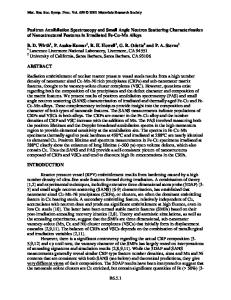Characterization of Free Volume in a Bulk Metallic Glass Using Positron Annihilation Spectroscopy
- PDF / 581,213 Bytes
- 9 Pages / 612 x 792 pts (letter) Page_size
- 56 Downloads / 291 Views
P. Asoka-Kumar, P.A. Sterne, and R.H. Howell Lawrence Livermore National Laboratory, Livermore, California 94550 (Received 18 May 2001; accepted 22 February 2002)
The free volume of metallic glasses has a significant effect on atomic relaxation processes, although a detailed understanding of the nature and distribution of free volume sites is currently lacking. Positron annihilation spectroscopy was employed to study free volume in a Zr–Ti–Ni–Cu–Be bulk metallic glass following plastic straining and cathodic charging with atomic hydrogen. Multiple techniques were used to show that strained samples had more open volume, while moderate hydrogen charging resulted in a free volume decrease. It was also shown that the free volume is associated with zirconium and titanium at the expense of nickel, copper, and beryllium. Plastic straining led to a slight chemical reordering.
I. INTRODUCTION
Positron annihilation spectroscopy is a powerful technique for the examination of microstructure, including point defects and other open volume regions, in a variety of materials.1 Using a combination of positron annihilation spectroscopy measurements, it is possible to gain insight into the size and concentration of open volume regions as well as the local chemical environment. Positron annihilation has been used to examine the free volume changes associated with annealing of a Zr46.7Ti8.3Cu7.5Ni10Be27.5 bulk metallic glass,2 where structural relaxation well below Tg led to decreases in positron lifetime, indicating a decrease in free volume. The technique has also been used to study the coordination of free volume sites in a Zr52.5Ti5Al10Cu17.9Ni14.6 bulk metallic glass,3 where it was determined that the free volume sites are associated with titanium and zirconium atoms at the expense of copper and nickel. In this work, positron annihilation spectroscopy was used to characterize the free volume changes associated with plastic flow and hydrogen charging of a Zr41.25Ti13.75Ni10Cu12.5Be22.5 bulk metallic glass. It is well known that plastic deformation in metallic glass alloys at low temperatures (T < 0.7 Tg) is due to the propagation of shear bands.4–6 Observations of the resulting failure surfaces reveal evidence of a liquidlike layer where the glass has softened significantly, producing a characteristic vein pattern and occasional molten droplets. The viscosity decrease is associated with a localized increase in the free volume relative to the surrounding material and local adiabatic heating in the shear J. Mater. Res., Vol. 17, No. 5, May 2002
http://journals.cambridge.org
Downloaded: 07 Dec 2014
band. Both thermal measurements and model predictions, however, suggest that significant local heating does not occur at moderate strains and strain rates.7,8 This suggests that free volume increases might dominate the initial flow process, although no direct experimental evidence for such free volume changes has been reported. Free volume models for the kinetics of the flow process in metallic glasses have been developed and predict
Data Loading...











